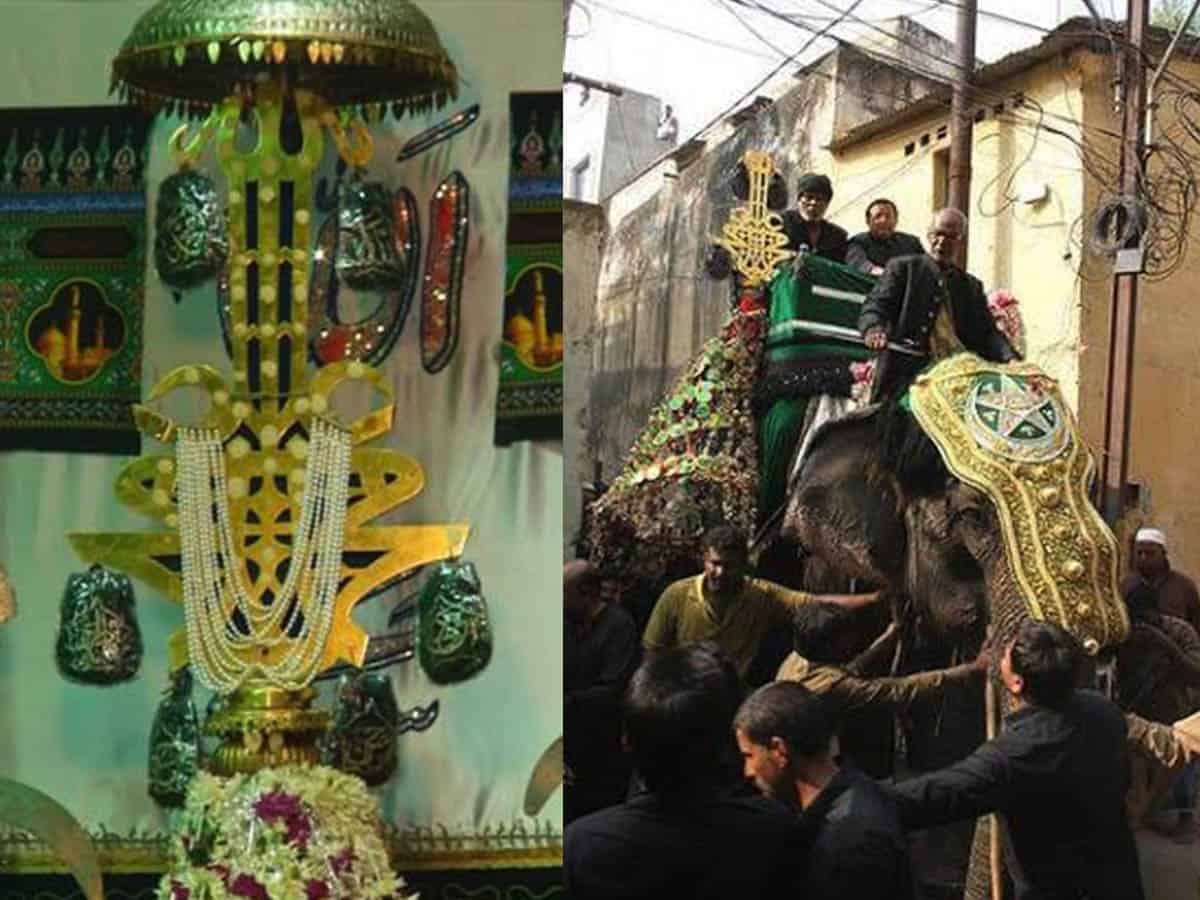
When Rani, the 83 year old elephant, gifted by Mir Osman Ali Khan in 1963 to the zoo, passed away recently in Hyderabad, the news triggered discussion about the procession of the Bibi ka Alam. Rani, like her peers, Rajani and Hashmi and earlier Hyderi, faithfully carried for many years the Bibi ka Alam in the annual Muharram ceremony on the day of ashura held with great fervour in the old city of Hyderabad.
These elephants were supple enough to navigate the route of the alam through the narrow lanes of Dabeerpura where the Bibi ka Alawa is located. The ritual of taking out the Bibi ka Alam on an elephant year after year, barring year 2020 when it was taken out on a medium sized open van, draws people from all corners of the city and beyond.
The passions associated with the Bibi ka Alam continue to generate religious and cultural discussion on the subject. The Bibi ka Alam dedicated to Fatimah al-Zahra and her son Imam Hussain is in line with the notion of Ahl-e-Bayt which centred on the family of Prophet Muhammad, particularly his daughter Fatimah al-Zahra, her husband Hazrat Ali and their sons, Imam Husain and Imam Hasan, and their descendants.
The Bibi ka Alam was prepared on the order of Hayat Bakshi Begum, who was the daughter of Muhammad Quli Qutb Shah, wife of Muhammad Qutb Shah and mother of Abdullah Qutb Shah. This particular alam is considered very sacred as it has a piece of the wooden plank in it on which Fatimah al-Zahra, who was also known as al-Batul, was given the ghusl-e-janaza. This relic reached Haidarabad during Abdullah Qutb Shah’s reign and makes the Bibi ka Alam very sought after as Fatimah al-Zahra’s death at a young age became symbolic of the chastity, purity and blessings of the martyr.
Shiism was popularized in Golconda-Haidarabad by the fifth Qutb Shahi sultan Muhammad Quli Qutb Shah and his Shia nobility was controlled by the then Peshwa Mir Momin Astrabadi. Shiite traditions and customs related to the month of Muharram evolved during this time with a special place for acquiring as many Shiite relics as possible from Arabia to consign to the respective alams in Haidarabad. The Qutb Shahi sultans sustained the belief that the alams carrying the relics of a martyr or imam were considered to be more pious.

The alams had a particular design with which they had to conform. From the sixteenth century, many ashurkhanas and alawas had come up in Haidarabad housing alams made in different metals. It is interesting to note that the design of the alams by and large remained the same except in a few cases. Sadiq Naqvi, an expert on Shiite practises in Qutb Shahi Haidarabad describes the structure of the alam. He says, “the lower part of the alam is fixed into a wooden rod called naiza or neza which is a hollow cylinder known as budi. The budi is fixed on one side with the sheet of a metal cut into an octagonal shape. This part of the alam is called paitha. In the middle of the paitha is a palm like portion called the hateeli. In this portion, craftsmen show their mastery by carving out a tughra which either has the name of the martyr to whom the alam is ascribed or the names of the Panjetan-e-Pak. The paitha carries two rods one on each side encircling it. These rods are known as sherja and are fixed on one side of the budi and the other side carries the head of a python. The upper part of the alam carries three strips in different shapes of which the middle one is generally shaped like the sword Zulfiqar.”
The Bibi ka Alam has one important addition that is a departure from the normal model but one that has become integral to its structure. It is the six black pouches that are found to be hanging from it on either side. On closer inspection of visual material and photographs of the Bibi ka Alam, and hearing oral testimonies from ashurkhana authorities and historians and those having heard from family elders about the black pouches, yet an unheard part of Hyderabad’s glorious historical accounts come to the forefront.
It is said that the six black pouches hung on the alam have precious jewel drops inside them containing jhumke of priceless emerald and ruby drops given as nazr by the fourth Asaf Jahi Nizam Mir Farkhunda Ali Khan Nasir ud Daulah who reigned over the State of Hyderabad from 1829 to 1857. Another narrative says that Mir Osman Ali Khan the seventh Nizam gave a nazr of large sized diamonds to the alam towards the end of his regime. Since the jewels are not available on display and are not in public eye, it is best to use the oft used term heere jawaraat for the contents in the pouches gifted by the two Nizams.

Brought out annually only during the yaum-e-ashura or the tenth day of Muharram, these precious jewels form part of the procession and are immediately returned to the vault in the Bibi ka Alawa on the same day itself. The vault is styled in the shape of a sarcophagus known as zarih where the jewels have been preserved in sealed pouches by the hereditary mujawars since the time they were presented as offerings to the alam.
The beautiful and charismatic Bibi ka Alam starts its ritualistic procession from the alawa itself at Dabeerpura and traversing the ashurkhana Khadam-e-Rasool, Peeli Gate, Purani Haveli, Alawa-e-Sartouq Mubarak, Aza Khana-e-Zahra, it reaches the River Musi over the Chadarghat bridge. This journey is described by Claude Campbell in his book Glimpses of the Nizam’s Dominions thus:
“The Bibi ka Alam, a beautifully modelled silver hand studded with pearls, is removed from its shrine at Yakutpura in the morning and is carried with much state on an elephant, and passing through the city, it reaches the Musi by the Chadderghat gate near the Oliphant bridge. After the last ceremony is performed the Alams are taken back to their shrines wrapped up in cloths.”
What Campbell refers to as the shrine is the Bibi ka Alawa at Dabeerpura which is the adjoining locality to Yakutpura. And the pearls are not studded on the alam but are draped around it, the same evident even today.
The Bibi ka Alam instituted by the Qutb Shahis is over 400 years old. It was first housed in an ashurkhana near the Golconda fort and in the year 1784 during the time of Mir Nizam Ali Khan Asaf Jah II the present building Alawe Bibi was originally constructed after the shifting of the capital from Aurangabad to Hyderabad in 1763.
Later, the alawa was renovated under the aegis of the renowned architect Nawab Zain Yar Jung in Mir Osman Ali Khan’s regime. The second, fourth and seventh Nizams’ contribution to the Bibi ka Alam and the alawa is yet another fine example of religious integration.
City Hyderabad’s magic will keep unfolding in different ways with its various well-known and little-known nuggets of historical heritage, one among which is the Bibi ka Alam kept at the Bibi ka Alawa, which is one of the star attractions during Muḥarram in Hyderabad.
Salma Ahmed Farooqui is Professor at H.K.Sherwani Centre for Deccan Studies, Maulana Azad National Urdu University, Hyderabad. She is also India Office Director of the Association for the Study of Persianate Societies (ASPS).

